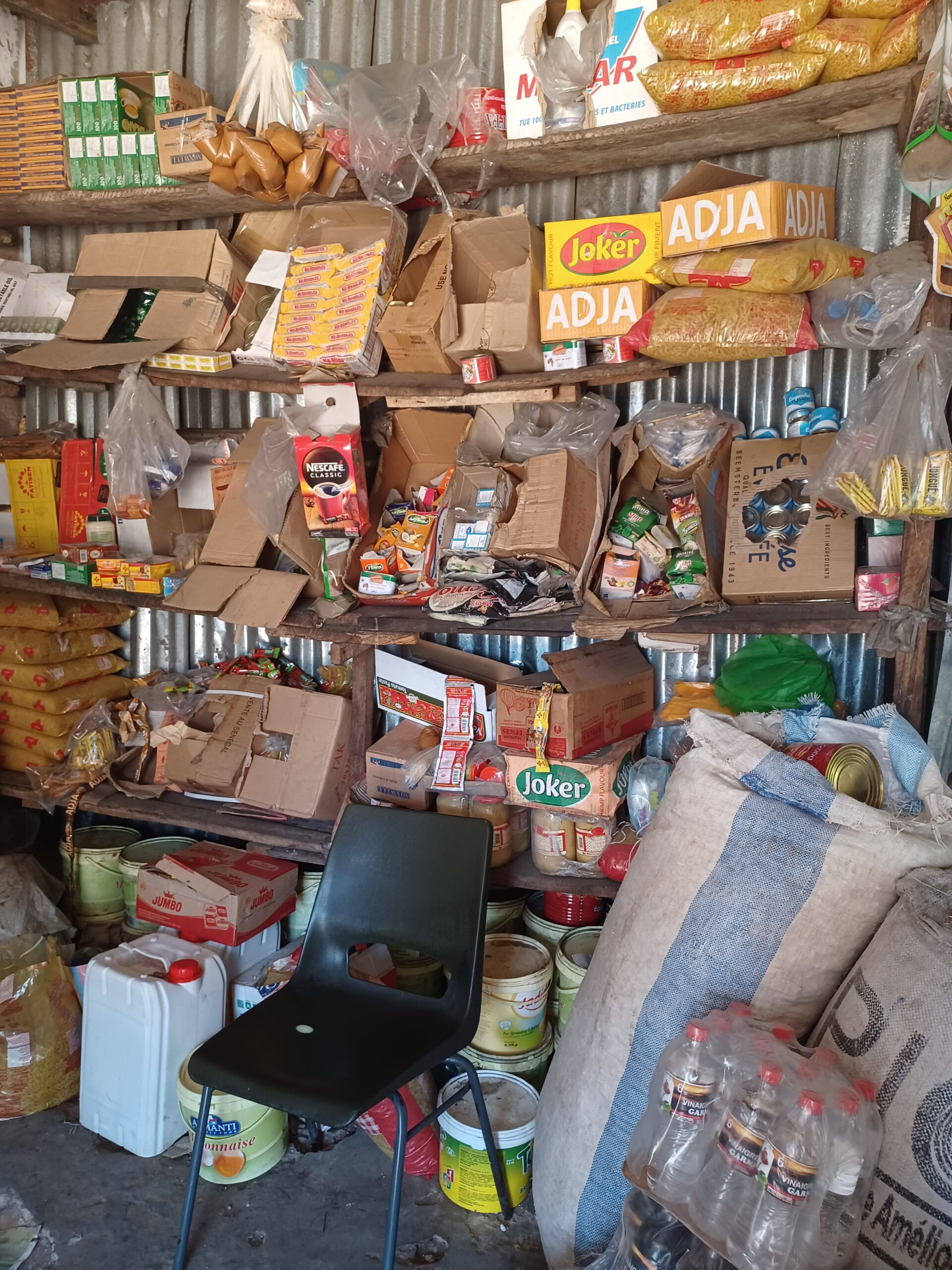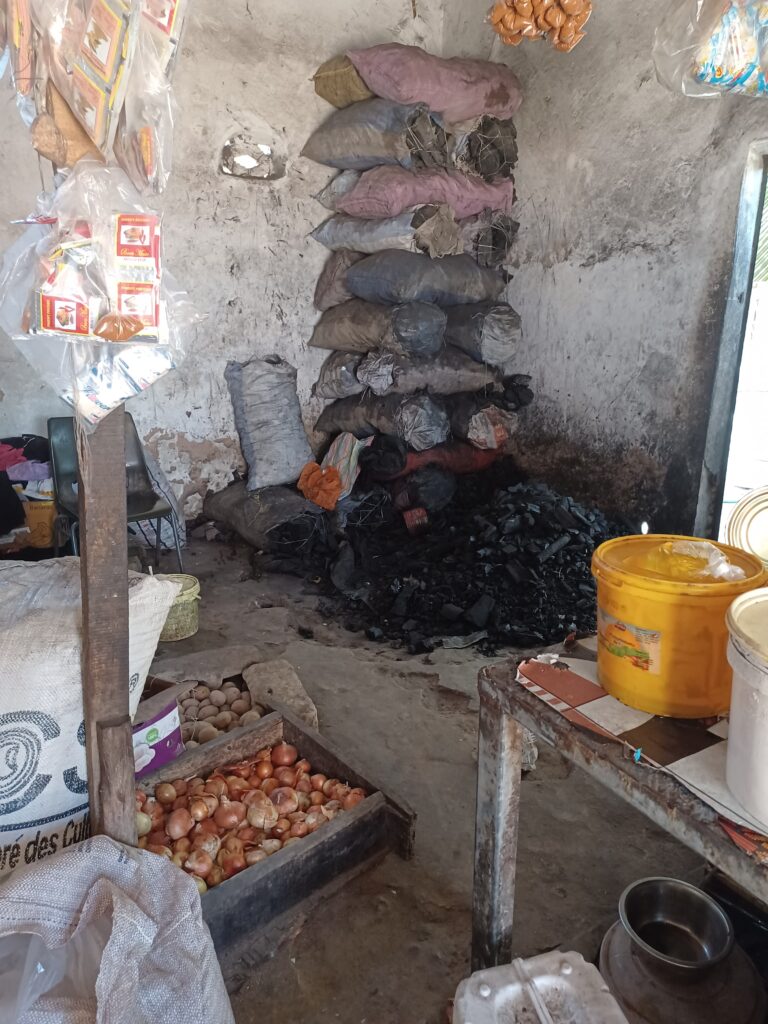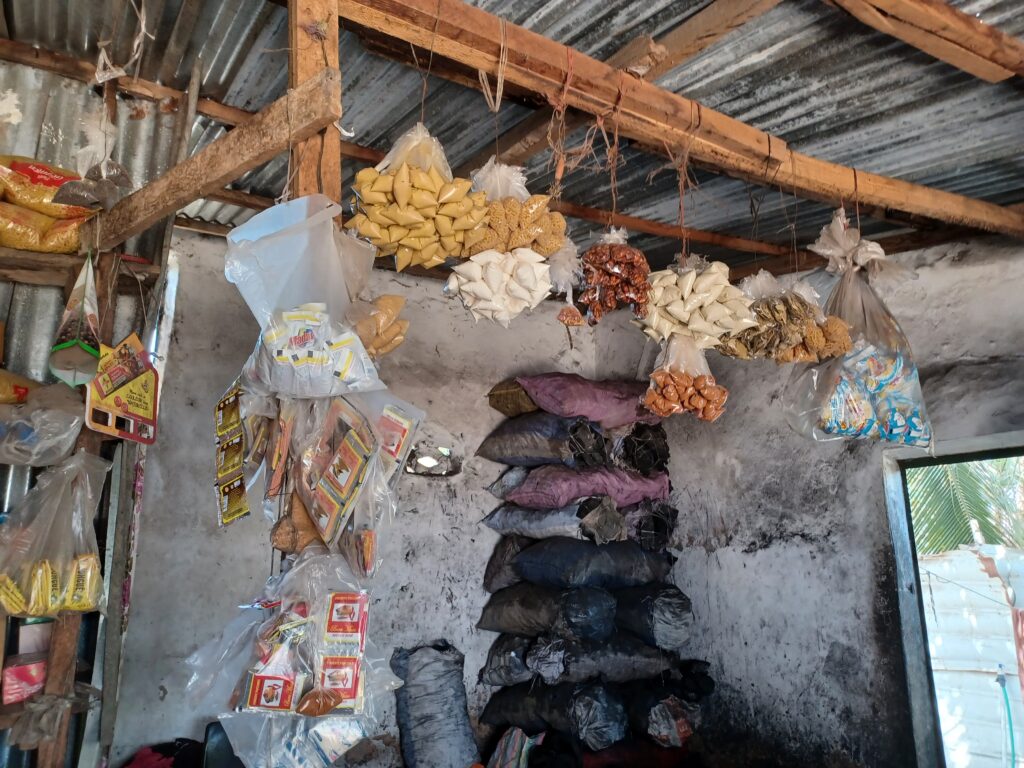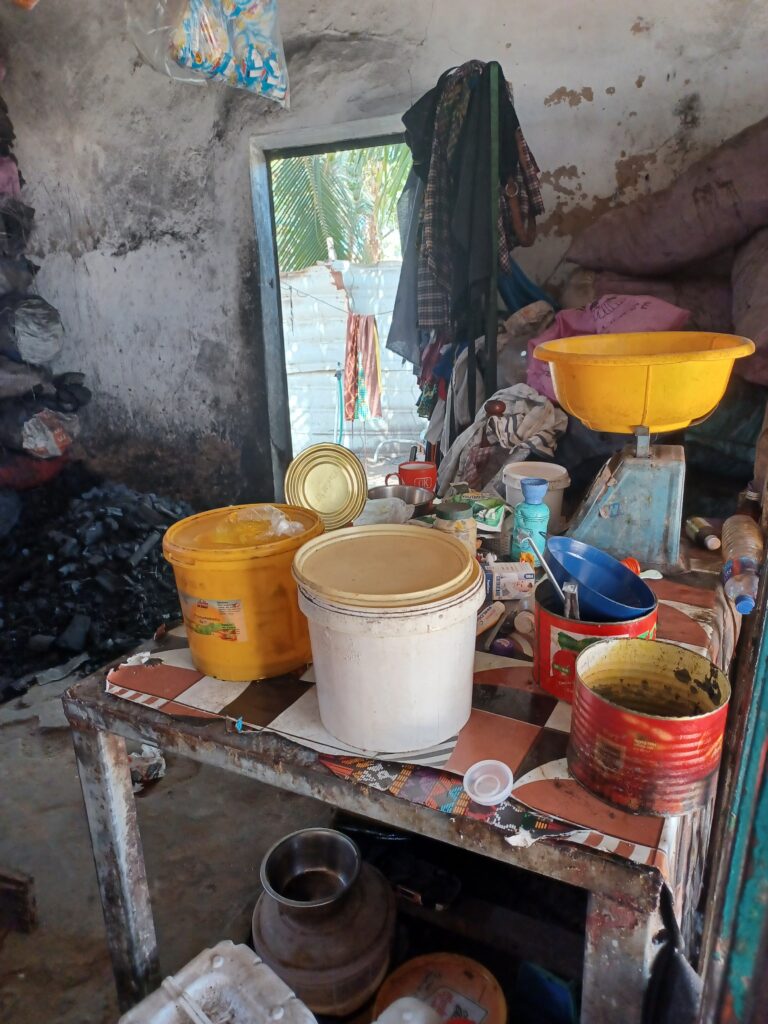
There are many of them – little inconspicuous local shops who more or less all sell the same stuff. For a European, entering such a shop can initially be a bit of an overwhelming experience. We are not familiar with many of the items sold here, nor do we have much knowledge about the cooking/eating habits of the locals yet.
Some of these stores have a freezer or a fridge. This shop here doesn’t, and is the one closest to my current home. So let’s explore the products together. On the top left corner in the shelf, there is Attaya green tea and black tea, followed by very tasty local peanut butter hanging in small plastic bags from the ceiling. After that, there’s a tin of tomato purée and a box of washing up liquid with the brand „Madar“ which comes from Senegal. On the right of the top shelf, there is a bag of Chinese pasta.
The second shelf contains again two pasta bags (of unfortunately very poor quality), tinned meat, sardines and ready-made Maggie soups.
On the third shelf you again have the notorious pasta followed by a choice of different soup stock cubes. I would say that JUMBO (pronounced as „JIMBO“) is the most famous amongst them. However, they contain artifical flavours and taste enhancers. After that, there’s the omnipresent NESCAFE, baking-soda followed by different fizzy powders containing artificial fruit flavours which can be added to plain water. By studying the bar code of these, I came to the conclusion that they are being produced in Malta.
Just a little sidepoint here: When Africans go on the so-called „backway“ through the Sahara all the way up to Libya from where they try to cross to Italy by boat, MALTA is one of the most aimed-at island after Lampedusa. But this was just a little sidepoint here. What I want to say here: You are what you eat! The things you are eating have an impact on your well-being and on your consciousness, too.
Although The Gambia is a country with amazing mangos for example, I was told that it’s considered „cooler“ to add fizzy mango powder (from Malta…) to your water than to make home-made mango juice from the fruits of your garden. The sweetness, the color and the taste of these powders is so overwhelming though that I could only add a little tinge to my drinking water. It just blows away your head if you put in the entire pouch…!
Next to the fizzy powders to the right, there is a box of condensed milk from the Netherlands which tastes fine and doesn’t contain too much sugar either. The lowest shelf again contains a lot of pasta and stock sachets, tomato purée in small quantity bags and peanut butter jars.
Under the shelf are plastic containers with mayonnaise, chocolate spread, margerine and tins of tomato purée. Okay – we need to explain something about these big containers. The system here is the following: In the morning, bread is being brought to these little shops. There are two types of breads. One bread is what we would call a „baguette“ (the longish French bread made of white wheat flour). It’s pretty dry though. The name for it here is „Senfur“. Then, there is another bread which is a bit smaller, and which is supposed to contain more items than just white flour and salt. It’s wetter, fresher and tastier, and it’s called „tapalapa“. So the locals go and get their breads at the store, and on demand, the shop keeper cuts the bread open and adds the topping of their choice on the bread: Choco spread, mayonnaise or margerine. One bread normally costs around 10 Dalasis, and if you add a topping, it costs 5-10 Dalasis more accordingly. So hence all the big plastic vessels under this shelf.

Now, let’s move to the next corner of the shop. Piled up in the corner is charcoal which is still widely used in The Gambia for cooking and for preparing the famous Attaya tea. In the boxes on the left, you have onions and „normal potatoes“ (which are imported by the way!).

What is hanging here? On the left on the wooden pole are different spices in small pouches such as ginger powder, ground pepper, etc. Hanging from the ceiling is mustard in small plastic bags, small pasta bags, wheat flour, dried red whole chillies, ground peanut powder, chilli powder, bay leaves, snacks, etc.

Now we are moving to one of the tables within the shop. There is a scale for weighing the items. There is soyabean and palm oil which can be purchased in small quantity, as well as tomato purée which may be purchased by weight.

The last and my favorite spot in this shop is the table with the fresh veggies! There is some cabbage on the right, and you might as well get just half of the piece which can come in very handy in case you don’t want to buy a full cabbage. The yellow round veggies are actually very hot chillies – beware! They have a unique flavor of their own, and it’s possible to get addicted to them. 😉 Tomatoes are there as well, and a few green peppers. The „white tomatoes“ on the left are actually „bitter tomatoes“ which turn sweeter as they are being cooked. In West Africa, they are added to thicken certain stew preparations. Sometimes some carrots are on the table, too, and some spring onions. On the right, there are various vinegars and a bottle of home-squeezed lime juice.
In front of the table, you get some bags with beans and different sorts of rice. Unfortunately, the rice is imported from America, and some of the peas, too. The white pea with the eye on it (the so-called „cow pea“) is a local bean. The rest is apparently all imported – which makes me so thoughtful.
When you look at all the available items in this store, it can be concluded that most of them (about 90% plus) are imported. I thought that The Gambia was situated below the Sahara, right? It’s a Subsaharan nation. If this nation was located within the Sahara, I would say, okay, things don’t grow here, so the food has to be imported from elsewhere (like e.g. Island which imports most of its goods). However, The Gambia has a very fertile soil and plenty of sunshine, and food (such as rice, beans, veggies, etc.) easily grows here. And the food could even be processed here (such as the omnipresent tomato purée for example) – if there was a will!
But the problem is that there is no will. The people are mostly occupied with their daily struggles and lack ideas and initiatives. The blame is generally put on the government for not providing this and that (such as machines for processing food). But hey – where there is a will, there is a way! If someone is determined and struggles for it, it will happen. However, the trauma sits much deeper than I initially assumed. It comes out as utter discouragement, sometimes even as pure lethargy. It’s like a child who has constantly been told by its parents that it’s good for nothing. And the daily struggle for survival kills all the experimental and creative spirit in people. Yes right, poverty paralizes. But in order to get out of this vicious circle, The Gambia has to start PRODUCING LOCALLY! It’s the only way out of dependency. It’s the only way to again get the prices under control. It’s the only way to again create jobs in a country where there is more than 50% redundancy.
Please note: The more goods are imported, the more expensive life will become, and the more people will go jobless. Produce locally for indepence, self-sufficiency and for job opportunities! Besides that, local products are fresher and therefore much healthier than imported one’s.
